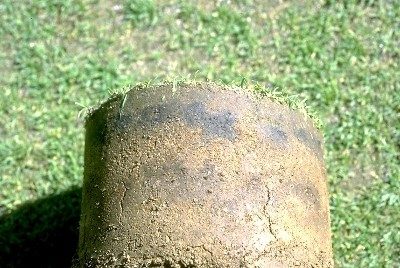Wastewater is usually rich in nutrients and levels must be considered when developing a fertilizer program. In general, turfgrass plants require 1.5 to 3.0 kg elemental S per 100m² per year for growth.
Sulphur (S) usually in the form of sulfate (SO4) is often high in wastewater and/or may become high due to acid treatment when irrigation wa-ter treatment is necessary.
If high levels of SO4 are pre-sent in the soil due to acid treatment or wastewater, the SO4 can quickly revert to re-duced S forms in the pres-ence of high soil moisture lev-els due to excess rain, soil compaction, excessive or-ganic matter accumulation, and layering in the rootzone that may cause a perched water table. The reaction of reduced S with excessive soil water levels - anaerobic con-ditions - results in formation of iron sulfide (FeS) and man-ganese sulfide (MnS) precipi-tates that gives the "black" to the black layer.
To help neutralize the soluble sulfate in water calcium can be applied. Calcium reacts with the sulfate to form gyp-sum (CaSO4), which is not as easily reduced in anaerobic situations. If calcium is not available in sufficient amounts to help remove ex-cessive sulfate light frequent applications of lime will help remove the sulfate by forming gypsum.
Picture 1 (beow): Cross section of a sand rootzone showing the presence of the black layer.

Argentine Stem Weevil Larvae can be Present in April
The Argentine stem weevil (Listronotus bonariensis) is home to much of eastern and southern Australia as well as New Zealand. The adult is active through most of the summer months. It is com-pact grey-brown weevil measuring slightly less than 4 mm in length.
Larvae cause the primary damage to turf. Once hatched the larvae mine or feed within the tillers of the turf plant. The larvae are creamy white with a small tan-coloured head. The key to weevil larvae is that they are legless.
Although damage from this weevil occurs during the early summer and through the summer months, the larvae are still active through middle to late April. Damage often looks like drought stress, however if the turf plants are "tugged on" they usually break off at the crown and the tillers are hollow inside.
